Feeling like there’s not enough hours in the day? That’s no surprise, since we’re quickly approaching the Winter Solstice. December 21 marks the shortest day of 2017–only 10 hours and 15 minutes in San Antonio, Texas, to be exact.
The celestial occasion celebrates the moment when, in the northern hemisphere, the earth leans furthest from the sun, resulting in short days and long nights. This makes for a great time to hole up by the fire, gather all those wildflower seeds you’ve collected all year and make seed balls.
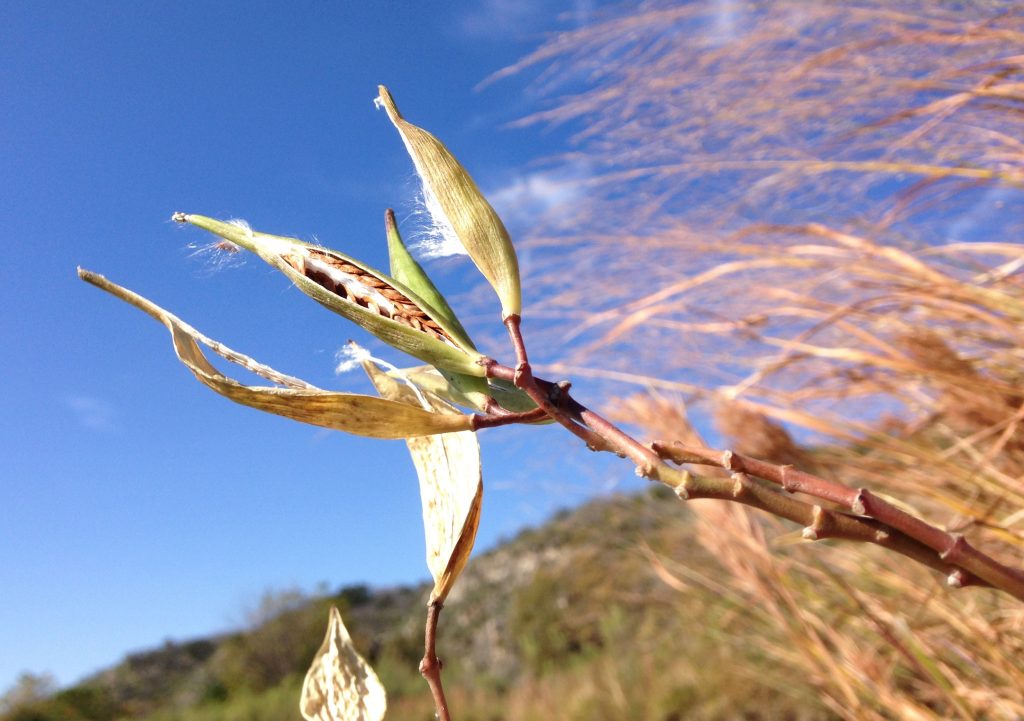
Swamp milkweed pods, Asclepias incarnata, ready for harvest on the Llano River. Photo by Monika Maeckle
Introduced in the 70s, seed balls are a form of “guerilla gardening” whereby seeds, soil and clay are mixed with water into tidy bombs that are said to have an 80% higher germination rate than simply broadcasting seeds onto soil. Adding red potters’ clay to the mix protects the seeds from being blown away by wind or consumed by bugs or birds. A dash of chile pepper gives them an added dose of protection.
I’ve been making seed balls for a decade and had mixed success.This mirrors my years of broadcasting hundreds of pounds of wildflower seed on the overgrazed acreage of our family ranch. Wildflowers are persnickety like that. They need an ideal combo of light, moisture, and temperature peculiar to their species in order to germinate. Both methods have left me baffled as to what combination of efforts results in success. I keep trying, and am especially motivated this year by a severe feral hog invasion along our river. The prolific wild pigs, which ranchers joke are “born pregnant,” disheveled a quarter-mile of our river road, undoing years of our riparian restoration in progress. Unwelcome Johnson grass will move in quickly to fill the gaps. I’m tossing seedballs to compete with the invasives.
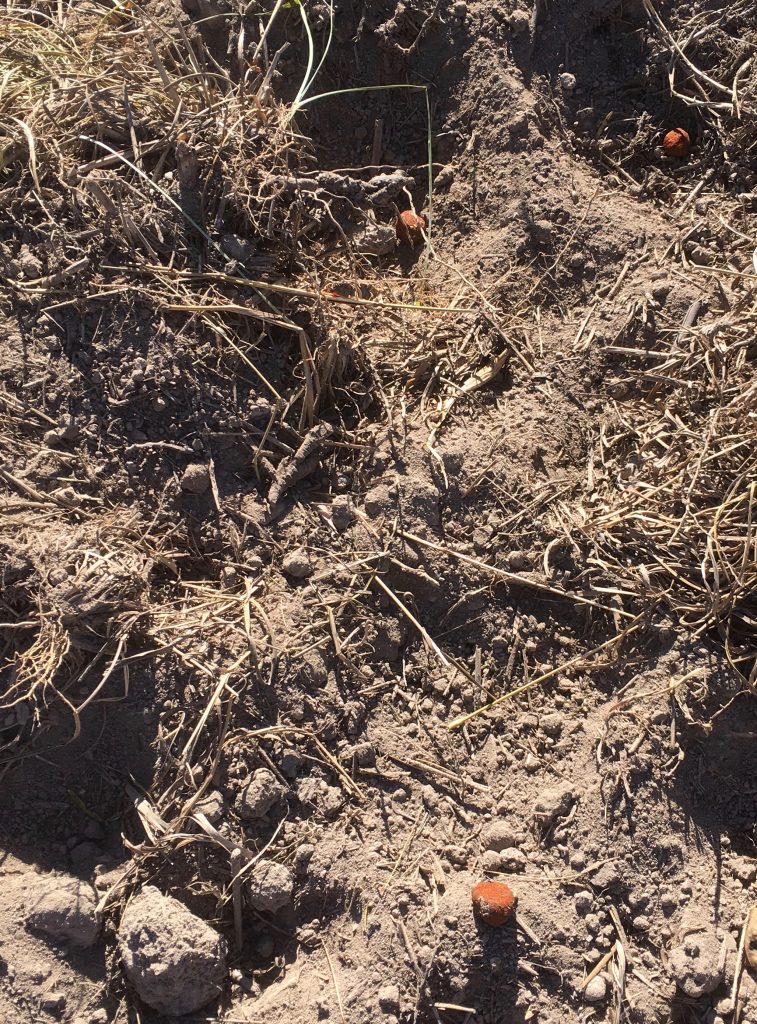
Feral hogs tore up our river front. Seed balls to the rescue. Photo by Monika Maeckle
My most successful seedballs germinated in the Chigger Islands that dot our stretch of Llano River. Laced with Asclepias incarnata, Swamp milkweed gathered from the same karst-riddled watershed, they grew into robust milkweed stands. They push out thin leaves that host arriving Monarch butterflies in the spring and pink flowers filled with nectar in the fall. By November, their plump seed pods invite another harvest. The late season caterpillar pictured below is noshing on a milkweed that started the year prior year as a seed ball.
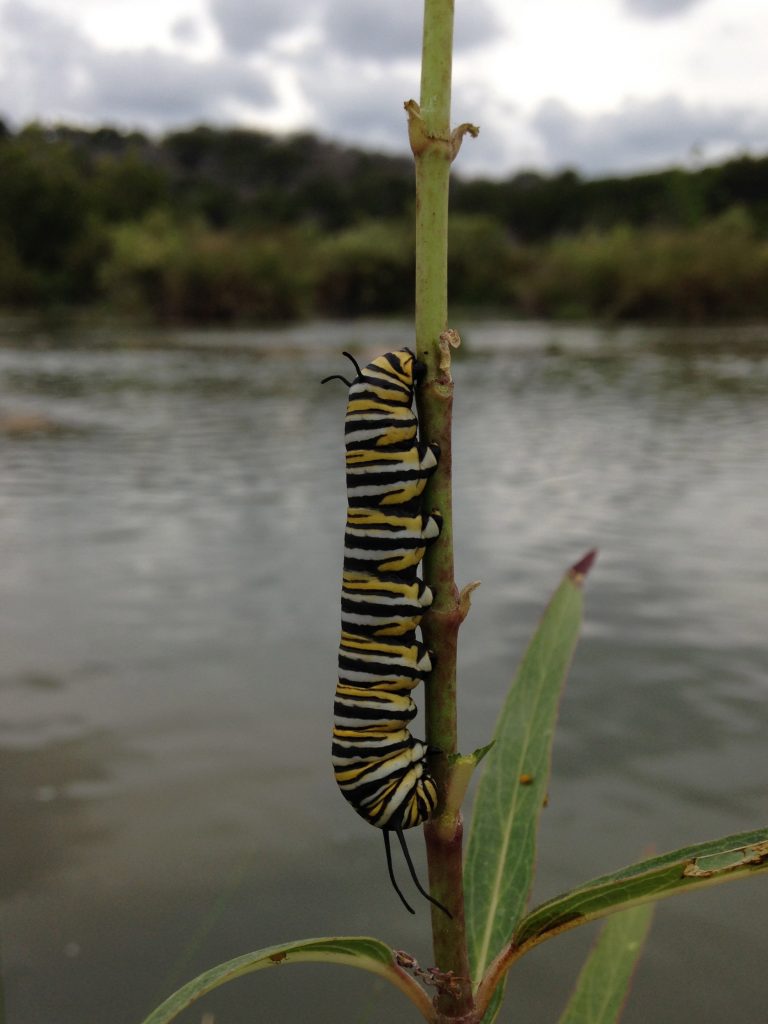
This late season caterpillar noshes on swamp milkweed made possible by seed balls. Photo by Monika Maeckle
Seed balls have become popular in recent years and are often tapped as an engaging educational activity for children of all ages at conservation events and pollinator festivals like the one we stage in October. This hands-on exercise takes participants back to childhood escapades of making mud pies. Rolling mounds of wet clay, seeds and soil into tidy round spheres–well, it’s just fun.
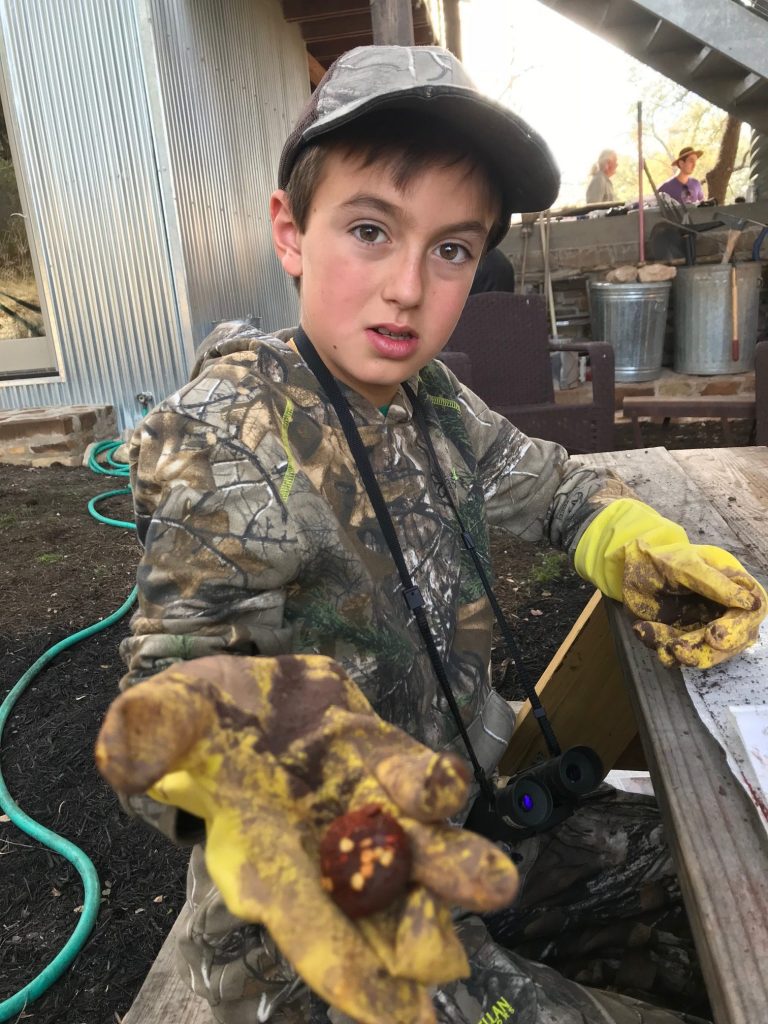
My friend Diego Harrison Smith helped make seed balls. Photo by Lisa Marie Barocas
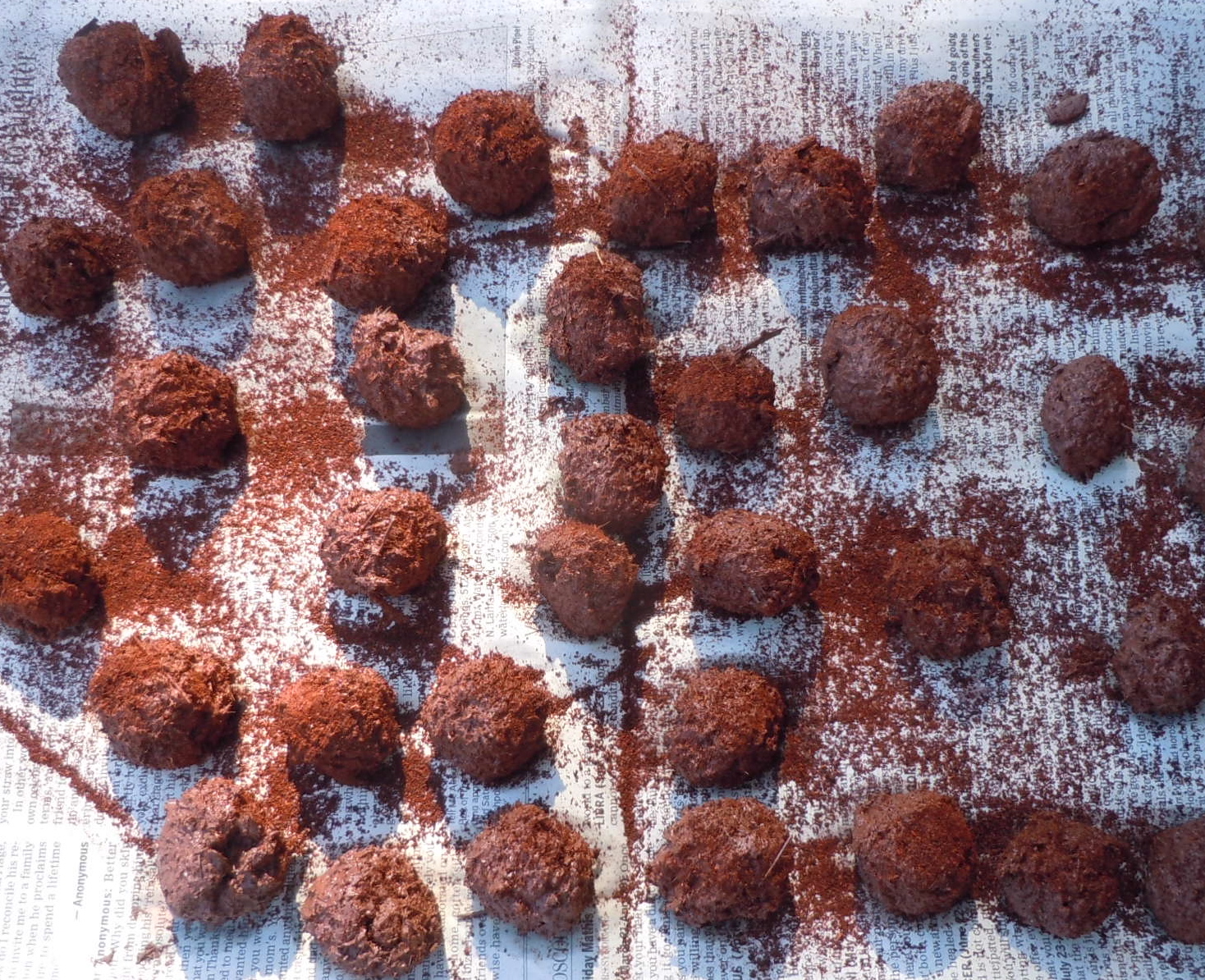
Let there be seed balls! Mark the march toward spring and help make next year’s wildflowers happen by making seed balls. Photo by Monika Maeckle
Our friends at the Ladybird Johnson Wildflower Center told us a while back that seed balls used for large-scale restoration projects often have a low success rate. Assuring the seeds make soil contact once the balls fall apart is a hit-or-miss proposition. Our friends at Native American Seed in Junction, Texas, suggest that when it comes to seed balls, size matters. Most people make them too large to break down and sprout. “No bigger than the size of an Almond M&M is good–and only a few seeds per seed ball,” said the seed purveyors’ Emily Neiman.

LEFT: Properly tossed seed ball. RIGHT: Improperly tossed seed ball. Photo by Monika Maeckle
Seed ball recipes vary as much as those for Christmas cookies. Some seed ball aficionados recommend a 3:2:1 ratio of soil, clay and seed, adding nutrient rich ingredients like worm casings or other natural fortifiers. The Lady Bird Johnson Wildflower Center and Native Plant Society encourage a concoction that includes sand. The Seed Ball Project suggests soaking the seeds for 12 – 24 hours prior to adding them to the seed ball mix. That sounds like a good idea, especially for hard cased seeds like bluebonnets and milkweeds.
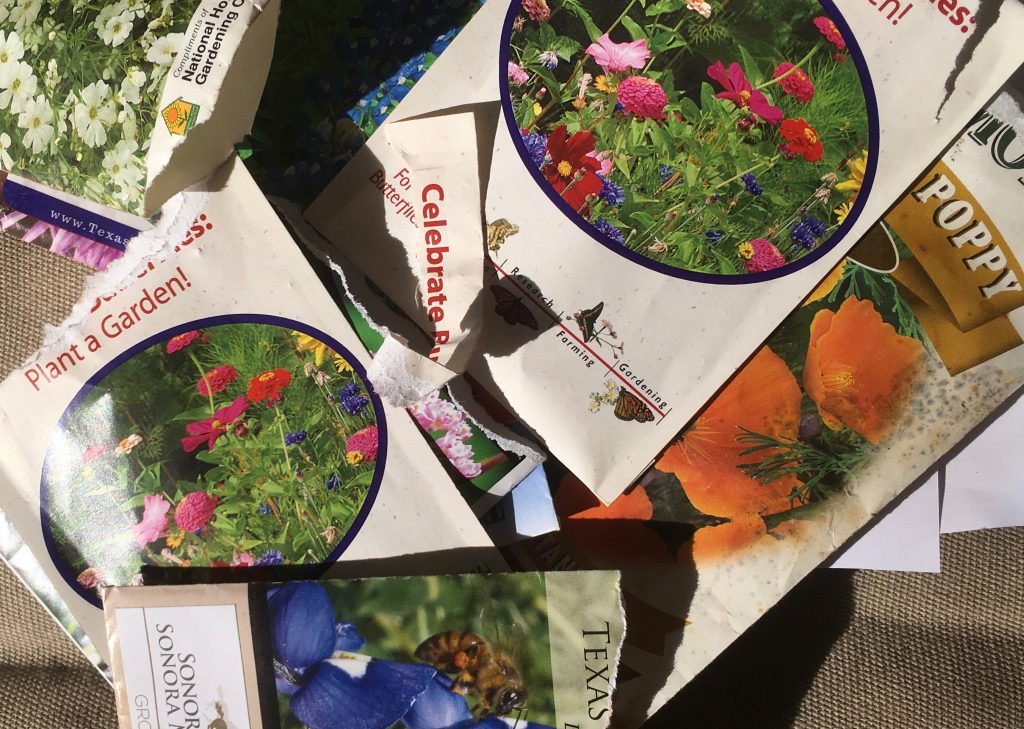
Got seeds? Use ’em up by making seed balls for next year’s wildflower meadow. Photo by Monika Maeckle
Our recipe includes three parts local or potting soil, one-two parts red potter’s clay powder (purchased from a pottery supply) and one part seeds. The clay binds the ingredients and keeps the balls intact. Add water until you get a workable dough that allows you to roll a spoonful of seed ball mix into a ball that doesn’t stick. If you find that your seed ball dough is too watery, just wait. The soil soaks up the excess liquid with time.
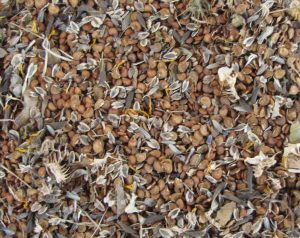
Put them on newspaper to set up and then add my secret ingredient: red chile pepper. The pepper discourages insects, birds and other critters from denigrating or eating the seeds, giving them a better chance to germinate and become wildflowers for pollinators.
Once the seed balls set up, usually after 24 hours, store them in paper bags for later use or toss them right away.
Generally, seed balls don’t require watering and you should NOT bury or plant them.
Simply toss them in a vacant lot, your front yard, or a wildscape like a ranch or roadside. Make sure they land where they can make contact with soil, as in the photo above. If the seedballs have to compete directly with grass, leaves or forbs, chances for germination decrease. Then, just wait for rain to melt away the clay casing, and nature will do the rest.
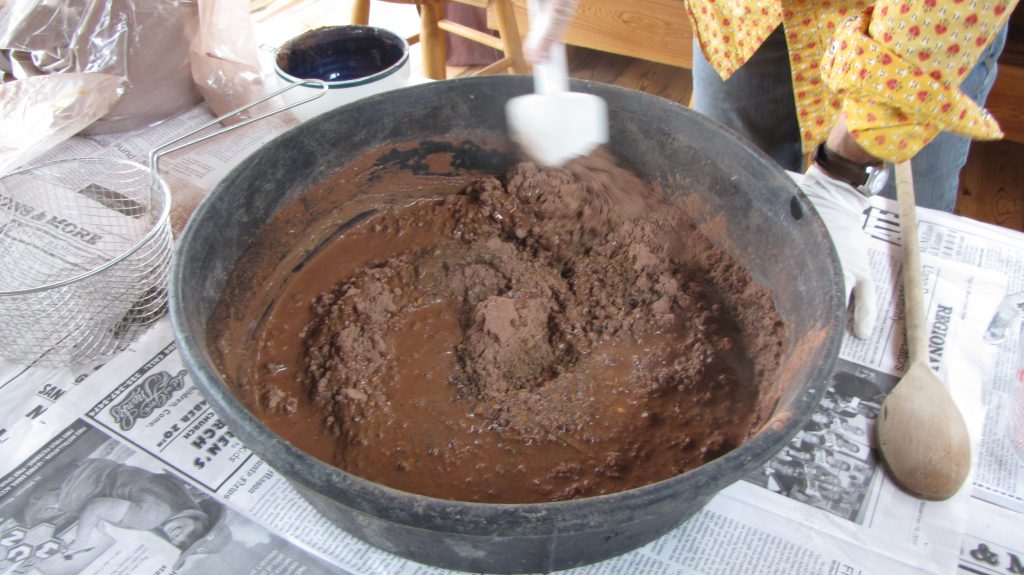
Soil, seeds, red clay, water–and chili pepper. Mix until you get a consistency that is easily formed into seedballs. Photo by Monika Maeckle
Remember to use only native seeds for wildscaping situations. Good luck and let us know how it goes.
Texas Butterfly Ranch Seedball Recipe
- 3 parts local soil or potting soil
- 1 – 2 parts red potter’s clay powder, also known as “terracotta powder” at pottery supply stores
- 1 part native wildflower seeds
- Water, as needed.
- Newspaper and cookie sheets for drying seedballs
- Stainless steal bowls or pots for mixing
More posts like this:
- Guidance on milkweed management confuses butterfly gardeners
- Late season Monarchs create gardening quandary
- What to do with late season Monarchs
- How to Raise Monarch Butterflies at Home
- Part II: More Tips on Raising Monarch Caterpillars and Butterflies at Home
- Tropical Milkweed: To Plant it or Not is No Simple Question
- Oh Those Crazy Chrysalises: Caterpillars in Surprising Places
- Butterfly FAQ: Is it OK to Move a Chrysalis? Yes, and here’s how to do it
- Should You Bring in a Late Season Caterpillar into Your Home?
Like what you’re reading? Don’t miss a single post from the Texas Butterfly Ranch. Sign up for email delivery, like us on Facebook, or follow us on Twitter, @monikam.

Have you tried any water beads for germinating?
National Geographic’s had a kid science book using a seed pushed into a water bead to be a enclosed germination chamber and then planted. What if it was placed in a seed bomb and then tossed? Would that increased success? I’m going to try it.